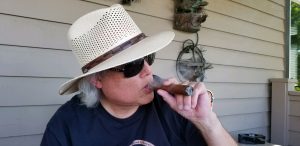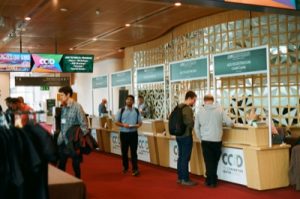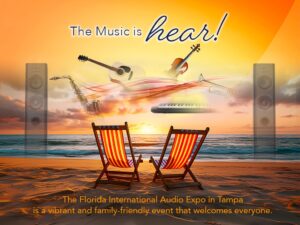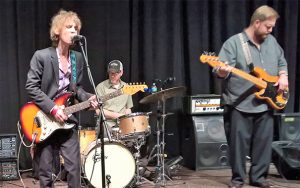
It's that time of year again and the Capital Audiofest has come around and an awful lot of people went to it. An awful lot of people; it was just packed in the hallways and some of the more popular demo rooms were pretty solid. I went, but because it was so big and so busy I didn't get to see half of what I wanted to see, so if I missed something that you think is important I'm sorry.
Let me explain first that the Audiofest is a high-end audio show in the Washington DC area which brings in people from across the country. It is so important to actually listen to different audio systems, whether or not you ever intend on buying them, just to get and keep a sense of what is out there and what is possible. As much as I think Positive Feedback is a great forum, I think making decisions on audio systems based on what some reviewer says is a bad idea. You have to listen to stuff and the Audiofest is a place where you can listen to a lot of different systems in a short period of time, even if not necessarily in the best situations.
This is just a quick overview of what I had a chance to see. At the Audiofest, there are a lot of rooms and a few of them are run by manufacturers showing off a single manufacturer's products. A couple of them are run by distributors and showed off the various products those distributors carried. Most of them, however, were run by individual dealers and showed systems that were set up by those dealers to show off their lines. I'm going to talk in this article about products, not about dealers, manufacturers, or distributors for the most part. It's not always easy to find a particular product at the show and sometimes I could find something but it was part of a system that was so odd that I couldn't tell much about it.

I will say also that there was very little actually great sound at the show. A lot of this had to do with the rooms; most of the dealer demos were in hotel rooms that were almost cubical and were acoustical nightmares. Very few of the dealers made any attempt to do any room treatment to deal with the room problems, and I never saw any of them with the kind of aggressive bass trapping that is required. There were products that I knew sounded great, in demos that sounded terrible. So I am not going to make a lot of sonic evaluations in this article because I was in very few situations where I could. But I can tell you about what I wanted to go back and listen to.
There were also some very odd-sounding things at the show occasionally, like a full-range speaker system that sounded for all the world like a 1950s table radio. I'm not going to mention systems like this because bad sound is not interesting. If you want to hear about bad-sounding systems, there are all sorts of car audio magazines you can read instead.
So what did I see and like? Let me put them in a few categories:
The Future
Remember back in the seventies when everybody bought a receiver? It was an integrated amplifier with a tuner and you could listen to music off the radio alone or you could add a tape deck and a turntable and listen to other sources too.
There's still a need for this sort of all-in-one device, but we are in the 21st century now and sources are different. Audio Group Denmark makes a box called the Maxxess Forte, which has an analogue input and several different digital inputs, but also has an integrated streamer built in, along with a class-D amplifier, "line preamp" type selection and gain control, and a headphone output. Just like that old receiver except with the streaming system in place of the tuner. There are some odd things here (nobody could explain what their "tesla coil noise reduction technology" was), but for somebody looking for a versatile system without tinkering and fiddling this is worth looking into.
Now, there were other streamers at the show. The Grimm Audio MU1 streamer was on display for instance, and Eelco Grimm is one of the better designers of digital audio hardware out there. It is beautifully designed. But this is a device that you attach to your existing system; it's a wonderful device but it's a device that is designed for the needs of audiophiles. The Maxxess on the other hand is a turnkey solution that you set up for people who are not audiophiles but who still need good sound. I wish the Grimm had got more attention at this show though.
Phono Stuff
Audio Technica makes great phono cartridges and not only do they make great MC cartridges, they make MM cartridges that track superbly and sound like MC cartridges. I always liked the AT440 in spite of it being very bright, but it's no longer available. After talking to one of the AT dealers there, they suggested I give the VM740 series cartridges a listen. Incidentally, AT had a gatefold-LP-style album of booklets with a full catalogue of their cartridges which probably gets credit for being the most beautifully put-together bit of marketing literature I have seen in a while.
AT was also showing the AT-ATR1000 cartridge, which is an MC cartridge with the coils mounted in the open attached directly above the stylus. This makes for more displacement (although less torque) than the conventional placement, so higher output impedance and lower losses in the system. It is a great idea from the sonic perspective but would seem to make the cartridge very delicate and in need of very gentle treatment. Not for houses with cats or children.
Also from Japan was Haniwa, which makes a very low-Z moving coil cartridge with a special preamplifier. I gather the preamp is a transimpedance amplifier to deal with the very low input voltage, and I gather the real win for the system is the low mass of the coil assembly when designed this way, but it was difficult to tell due to language issues. This is very much worth looking into though, and I am very curious what the front end of their preamp looks like.
Koetsu had a dealer there showing off their latest line of cartridges, and they denied the rumors that the company was going to be shutting down which were circulating at the show. With the death of the founder and then the death of his son last August, we have to expect some changes. These guys make such beautiful handmade phono cartridges that it would be a shame for anything to change with them.

VPI Turntables had a room there but it was so crowded and loud I didn't even get a chance to look inside, and I feel bad about that because I do like the VPI products.

Fern and Roby out of Richmond, VA was also showing off their Montrose Heirloom Turntable, which was beautifully-made and worth checking out.
Technics was there, and this was interesting because I never liked the Technics direct-drive turntables. They always struck me as broadcast tables designed for fast cuing and start-up at the expense of flutter. With tables like the old SP-10, I could always hear cogging on long piano notes because of the constantly changing torque from the motor. Technics is trying to address this problem as well as a lot of the arm issues on the older tables, with the Grand Class SL-12 turntable. I think this could be a good thing, and it clearly an advance in direct-drive mechanisms. Is it enough to make direct-drive usable in an audiophile environment? I don't know, but it is definitely worth testing to see. Technics understands the problems and is heading in the right direction at least.
Record Cleaners
All kinds of record cleaners this year! First of all, we had three different ultrasonic cleaners, from Kirmuss, Klaudio, and iSonic. All of them looked effective and able to do the job and all of them are worth checking out especially if you are often dealing with grubby old records that need deep cleaning without contaminating anything else.

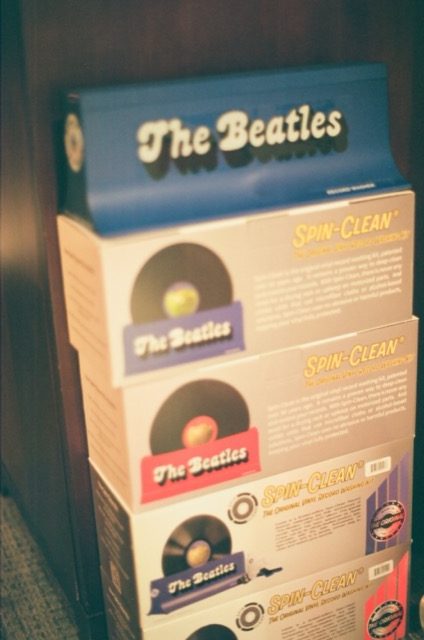

Remember the old Spin-Clean from back in the sixties? A small electric motor rotates your record past a set of brushes? They are back and there is a new Beatles Edition model it seems. How well does it work? I don't know, but it got a rave review in PF a while back.
Loricraft, which is a division of SME, was selling a vacuum record cleaner that was designed on the model of the Keith Monks, with a small vacuum intake that is passed across the record on an arm. The Monks cleaners are much more delicate than the various models which use a slotted vacuum intake, and can be used on acetates which other models cannot. I suspect that this model can also be used on acetates which would be a big deal since it is half the cost of a used Keith Monks machine today.
Loudspeakers

The Quad name is appearing again on electrostatic speakers, and there was a pair of the Quad 2812X electrostats on display at the show. I couldn't tell much about the low end in the room they had, but they had the open clean sound that I always associated with the original Quad ESLs. Worth checking out if you are an old Quad fan.

Now, something really interesting was that ATC was showing off their ATC SCM19A speakers... and they looked very familiar to me. It turns out that the ATC SCM19A home audio speakers are the same speakers as the ATC SCM20A studio monitors, just with a bit more attention to making the cabinet look god and fit in with your decor. They take the philosophy that the home playback system should sound like the system the music was mixed on, for best translation, and you cannot deny that is a good plan.
On the other hand, Alan Sides from Ocean Way takes a totally different approach. Ocean Way is mostly known in the studio world for very large horn-loaded monitors that can play loud without problems. AGD Productions was selling Ocean Way's new design for the home audio market which took a very different approach. Their Eureka speakers have an oddly-reinforced cabinet and conventional drivers, but like the big monitors it was designed for large amounts of headroom and it probably had the cleanest-sounding demo I heard at the show this year. I do think they probably should be also showing off some of the big horn systems as well, though, which I think would have an audience in the high end world.
A third company from the studio monitoring world was TAD, which is a small Japanese company that started off as part of Pioneer, and which has long made big horn monitors for studio monitoring applications. They are now making some smaller speakers for home use, including the Evolution Two which I heard at the show. Again, I would think their big horn systems would sell well in the high end world although they weren't exhibiting them here.
Mon Acoustics was showing a small speaker system called the Platimon which used two 8" woofers and an ESS-style tweeter. I couldn't tell much in the demo except that it was not spitty like some ESS drivers are, and it is worth checking out under better conditions.
Joseph Audio had a conventional 2-way floorstanding speaker called the Perspective2 Graphene, which uses graphene-covered metal cones on the woofers. It wasn't at all spitty or clangy and again it was another speaker that I would like to listen to under better conditions.
Magnepan was also there and having used Magnepans for the past thirty years myself I am big fans of theirs. They were showing a number of speakers including their entry-level LRS+ system, but what I found most interesting was their MG-X Upgrade Program in which they will make a number of different upgrades to their speakers before or after sale. Some of them were simple such as better capacitors, connectors, and wiring, but in other cases they were more dramatic such as changing the MG1.7 from a three-way system to a two-way MG1.7x.
Mofi was showing off their SourcePoint 8 Speakers which I really wanted to listen to, but I missed the room and wasn't able to get back to it before my train left to go home.
Lots of companies were showing off big horn systems, many of them copies of classic designs, and some of them very new designs. Classic Audio was there again and not only did they have their replicas of classic horn speakers but they were also showing their T-1.5 Reference which was a beautifully made 3-way system with a midrange horn but conventional bass and treble drivers. They have a very, very big sound to them. I'm not a horn fan at all but if you are you should definitely check these out.
If you remember the Linaeum tweeter design, it was invented by a guy named Paul Paddock and it was very popular in the late eighties and early nineties. Since then, the designer has continued to develop the design and made much larger versions. His new company, MC Audiotech, is making speakers based on his "Wide Band Line Source" drivers, which are scaled up versions of that tweeter design that are usable for much of the audio range. The demo they did sounded very strange and you could tell there was something odd going on by the weird ringing on record pops, but that likely had nothing to do with the speakers. Once again, I think we have a good product spoiled by a poor demo and this speaker should definitely be listened to more carefully in a better environment.
Also an interesting new design was the HVT wideband driver made by Arion Audio and used in their Apollo 12 speakers. I couldn't tell a lot under show conditions but they weren't spitty and seemed to have fair imaging in the room.
Acoustical Treatment
There were some dealers bringing in some acoustical treatment products. I saw some promotion of the Jocavi acoustic panels, as well as some stuff from GIK acoustics. These are fine products and products that were needed so seriously in some of these rooms but were applied with way too light a hand when they were applied.
Headphones


There was, as usual, a headphone hall with lots of different folks showing off headphones. Normally I don't spend much time here, as I view headphones as a necessary evil rather than a favorite listening mode, but I checked out a few things including the Audeze MM-100 headphones. I liked the open sound and the clean top end which was detailed without being over the top, but the amount of outside sound leakage was a deal breaker for me because I mostly use headphones in places where outside noise is an issue. But a lot of people today are using headphones because they are in dorms or small apartments where they don't have enough space to set speaker systems up properly, and in that kind of environment these are worth checking out. I liked them more than the more expensive MM-500, to be honest.
Amplifiers
As a studio guy I mostly know Bricasti for their M7 reverb unit, but they make a lot of other fine gear too and that includes the M28 monoblock amplifiers. Giant complementary bipolar output stages, 200W output into an 8-ohm load but the effective output impedance is very low for good control of any speaker. Not cheap, but it's designed the way a solid state amp should be.
If on the other hand, you want 200W or so of tube power, the Convergent Audio JL7 BP is a monoblock with eight of the new KT150 tubes in a push-pull arrangement of four paralleled each. Automatic biasing system is in place so there's no fooling with bias, just waiting for a light to turn green. Again with a gigantic power reservoir for peaks, and the ability to drive all kinds of loads.
Electrocompaniet was showing their AW800m 800W monoblocks, again very large bipolar amplifiers with very wide available bandwidth, but using a new output stage that they claim makes for a lower output impedance than was possible in their previous generation.
And VK Music was selling a variety of kit amplifiers from Japan, some of which were retrofitted with Lundahl transformers. One of them was the Sun Valley SV-128ii power amp... two KT170 output tubes, a GZ34 rectifier, and four EF37A small-signal pentodes. The EF37A is basically a 6J7 in European clothing; very low noise and good shielding. He was also selling the Elekit single-ended tube amplifier kits from Japan as well.
DSP
Danville Signal was showing off their dspNexus digital audio processor. This is a small box with a SHARC DSP processor inside it, and some processing software with various modules inside. From your PC workstation you can design a signal processing framework with filters and delays and summing networks and gain changing boxes, and the PC software will generate a wire list to connect those modules, and a list of the parameters for all those modules, and download it into the standalone dspNexus processor. This is a custom crossover machine, which will let you implement any custom crossover in the digital domain. It will let you do a lot of things that aren't possible with an analogue crossover. But it could also be a broadcast processor or a delay unit for fill speakers. The possibilities are endless because it's a general purpose programmable box. I think systems like this are the future for younger audiophiles who have the tinkering instinct but are most comfortable in the digital world, too.
A company called Caprice Audio was selling their Core Audio Plug and Play Optimization System. This was a magic box that goes into your signal path and introduces some sort of filter that makes everything sound better. We aren't quite sure what it does except that it connects both to your speakers and your signal sources. They were long on marketing and short on implementation details but who knows? Maybe it does sound better. This is another one we'd really like to know more about inside.
Miscellaneous
The local Pacifica radio affiliate, WPFW-FM, was there with a booth talking to people about their programming. As a long-time WPFW listener and a fan of their Mambophonic High-Fidelity, I can really appreciate their great jazz and other music programming even if I don't agree with their politics. Give them a listen at https://wpfwfm.org (especially Sunday at 6:00 pm for the Latin Flavor).

And I saw all kinds of pro audio people, from Per Lundahl the transformer expert to the Hazelrigg Brothers who are taking over Doug Fearn's tube electronics manufacturing as Doug gets closer to retirement. Doug was there and I missed him unfortunately.
Equitech was there showing off balanced power systems. I kind of think the advertising on balanced power is a bit over the top, but it is a good solution for a couple of different power problems and worth investigating if you have them. It reduces hum due to chassis leakage but also you get the free bonus of a low-pass line filter and reduced power line noise as a happy consequence of the line transformer.
The Auction

Ken Fritz, a longtime audiophile who is well-known for having built the most elaborate in-room speaker system, died in 2022 at age 80. He left behind a legacy of many listeners who learned from him over the years, but he also left behind an enormous house full of audio gear ranging from some incredibly valuable exotica down to what is indisputably junk. After two years of selling much of it off, his family decided to put what was left, including his in-room playback system, up for auction at ebidlocal.com. There was a representative of the auction house at the show, and a booth in the lobby covered with cards advertising the auction. I wish his family the best in this.





Conclusion
The convention was much larger than last year, with more vendors and more attendees and more interesting new products. There were some folks that we missed and no free copies of Stereophile and AudioXPress but on the whole I think the convention is coming back from the Covid-era losses and I think anybody who cares at all about audio needs to go to this event.










